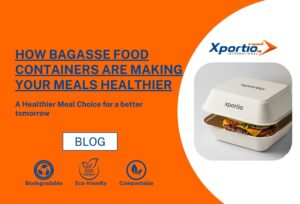Bagasse Paper Plates and Compostable Tableware Are Outpacing Paper Products
As demand for sustainable packaging soars, businesses and importers are asking: Is switching from traditional paper to bagasse paper plates actually cost-effective?
With the rising shift toward eco-conscious consumption, the battle between paper-based disposables and compostable bagasse tableware is heating up. For anyone seeking to make informed decisions—especially an exporter of bagasse paper products—understanding the cost, functionality, and long-term value is essential.
Let’s break it down.
Table of Contents
Understanding Bagasse and Paper: The Basics
Bagasse is the dry, pulpy residue left after extracting juice from sugarcane. This natural byproduct is now being molded into bagasse paper plates, bowls, clamshells, and trays—offering a zero-waste solution that replaces traditional materials.
In contrast, paper plates are typically made from virgin or recycled wood pulp. While paper seems eco-friendly on the surface, it often requires chemical coatings (like polyethylene) to become water-resistant—reducing compostability.
The Global Shift: Why Importers Are Choosing Bagasse
In North America and Europe, the rise in plastic bans and green procurement guidelines has fueled demand for compostable bagasse tableware. Retailers, food chains, and distributors want packaging that’s both functional and planet-safe.
A recent report by Smithers Pira shows a 34% YoY increase in import demand for bagasse paper plates in 2023 alone.
For wholesalers and procurement heads, the shift is no longer a trend—it’s a necessity.
Is Bagasse Actually Cheaper Than Paper? Let’s Talk Costs
Raw Material Cost
Bagasse is a byproduct, meaning the raw material cost is negligible compared to the rising price of wood pulp. This gives exporters of bagasse paper products a natural price advantage in large-scale production.
Processing & Molding
While molding equipment for bagasse paper plates is slightly more complex, it pays off in the long run. The energy consumption per unit is lower compared to paper processing, especially in water use and drying time.
Bulk Pricing
When ordered in container loads, the per-unit cost of bagasse plates can be 5–15% lower than coated paper products, depending on size and customization.
Logistics and Export Considerations
From an exporter’s perspective, bagasse paper plates hold several logistical advantages:
Compact packing with fewer breakages
Better resistance to humidity during shipping
Consistent shelf life without curling or deformation
As an exporter of bagasse paper products, these benefits reduce returns, improve customer satisfaction, and support brand trust.
Sustainability & Certification: Going Beyond the Label
Here’s how bagasse stacks up against paper:
| Feature | Bagasse | Paper |
|---|---|---|
| Compostable | ✅ Yes (90–120 days) | ⚠️ Only if uncoated |
| Renewable | ✅ Made from sugarcane waste | ⚠️ Requires tree felling |
| Energy Use | 🔽 Low | 🔼 High |
| Water Use | 🔽 Minimal | 🔼 High |
| Certifications | BPI, OK Compost, FDA | FSC, sometimes BPI |
Compostable bagasse tableware has been certified under BPI and TÜV standards, making it ideal for buyers with strict compliance needs.
Heat, Oil & Moisture Resistance: A Real-World Advantage
Bagasse paper plates are:
Naturally oil- and grease-resistant
Safe for microwave and freezer use
Withstand temperatures up to 200°C
Meanwhile, coated paper loses shape with hot or wet foods—limiting its usage in real-world foodservice scenarios.
For food packaging importers or large food chains, this durability translates to better customer experience and lower complaint rates.
Better Margins and Branding Power
By offering compostable bagasse tableware, importers and distributors can:
Sell to premium markets (eco cafes, organic stores, events)
Leverage “plastic-free” and “zero-waste” marketing
Add private labeling or embossing for brand positioning
This opens up higher-margin opportunities compared to generic paper disposables.
An experienced exporter of bagasse paper products can also assist with branding, MOQ flexibility, and region-specific packaging standards—critical for growing private-label brands.
Use Case Comparison: Bagasse vs Paper
| Industry | Best Choice | Why |
|---|---|---|
| Quick Service Restaurants | Bagasse | Sturdiness under heat & moisture |
| Institutional Catering | Bagasse | Compostable & durable |
| Outdoor Events | Paper | Lightweight, cost-friendly |
| Delivery Platforms | Bagasse | Leak-proof & stackable |
| Airlines & Railways | Bagasse | Space-saving + freezer-safe |
While paper still fits low-budget, short-use scenarios, bagasse paper plates dominate in quality-demanding applications.
Challenges: What to Watch For
Bagasse availability depends on sugarcane harvest cycles, which can fluctuate. However, an experienced exporter of bagasse paper products can plan procurement around these cycles and maintain stock continuity.
Other challenges:
MOQ might be higher for custom designs
Limited availability in some packaging types (e.g., lids)
Yet, for most standard SKUs like bagasse paper plates, availability is stable and export-ready year-round.
Final Thoughts: Bagasse Is the Better Investment
When comparing bagasse paper plates to traditional paper disposables, here’s the bottom line:
✅ Lower long-term costs
✅ Superior heat and oil resistance
✅ Genuine compostability without chemical linings
✅ Better brand perception in export markets
With growing global demand, supported by strict environmental policies, choosing compostable bagasse tableware is not just an ethical move—but a strategic one.
Ready to Import Bagasse Tableware?
Looking for a trusted exporter of bagasse paper products?
We provide custom molds, OEM branding, and global delivery with flexible MOQs.

